Butters and semi-hard oils (these are oils with a melting temperature just around the room temperature like coconut oil and babassu oil. They are solid in winter and become liquid in summer) are used rather sparingly in emulsions. Formulators usually use high concentration of butters in balms, sticks, melts and co but in an emulsion, they are hardly used higher than 5%.
Generally butters are associated with hardness, heavy or a rich, greasy skin feel but the reality is a far cry from that.
- Butters, compared to liquid oils have a much longer shelf-life and a much higher thermal and oxidative stability.
- If they are formulated and processed correctly they provide you with luxurious creams with a velvety skin feel that do not feel heavy or greasy at all.
- You can easily hot process them without the fear of degrading them and this enables you to apply tricky ingredients such as ceramides or ascorbyl palmitate that need a high temperature to be incorporated in the emulsion
In the past, we have shared some KISS tutorials using butters:
We took the KISS formulation (with some tiny tweaks) and used some of the butters and semi-hard oils we had in stash and the results were quite astonishing.
This is our frame formulation:
| Phase A |
|
| Distilled or deionized water |
to 100,0% |
| Natural chelator PA-3 |
0,1% |
| L-Arginin |
0,3% |
| Na-PCA |
2,0% |
| Aquaxyl |
2,0% |
| Phase B |
|
| Solagum AX |
0,4% |
| Phase C |
|
| Polyaquol 2W |
5,0% |
| Butter* |
20,0% |
| Tocopherol |
0,3% |
| Phase D |
|
| Versatile preservative TBG |
1,0% |
| Litsea cubeba oil |
1,0% |
| Lactic acid |
if necessary to reduce the pH |
* we used the following butters and oils:
Procedure:
1- Blend phase A and C in separate heat proof beakers
2- Disperse and hydrate the gum in phase A @RT
3- Heat both phases in a water bath between 80-85 oC
4- Emulsify the oil phase in the water phase and homogenize for a few minutes
5- Start cooling down. The cool down phase is much longer compared to when you make emulsions with liquid oils. There is no need (or no use) to use an ice bath or fridge or freezer. To avoid graininess and crystalization you need patience and a slow cool down. There is no short cut to it.
6- After the cool down and stirring for at least a couple of hours add the essential oil, prepare a 10% dilution and measure the pH. We deliberately added l-Arginine to the water phase to increase the pH at the beginning because we know that our preservative system reduces the pH. In our case the pH varied between 7,5-8,5.
7- Add the preservative. Prepare another 10% dilution and remeasure the pH. The final pH should be between 5,2-5,5. You may need to add lactic acid to reduce the pH at the end.
In this video, I show you our results. Each sample is a unicat for itself. Our team collectively selected murumuru and cupuacu creams as the favourite.
Stay safe and creative


